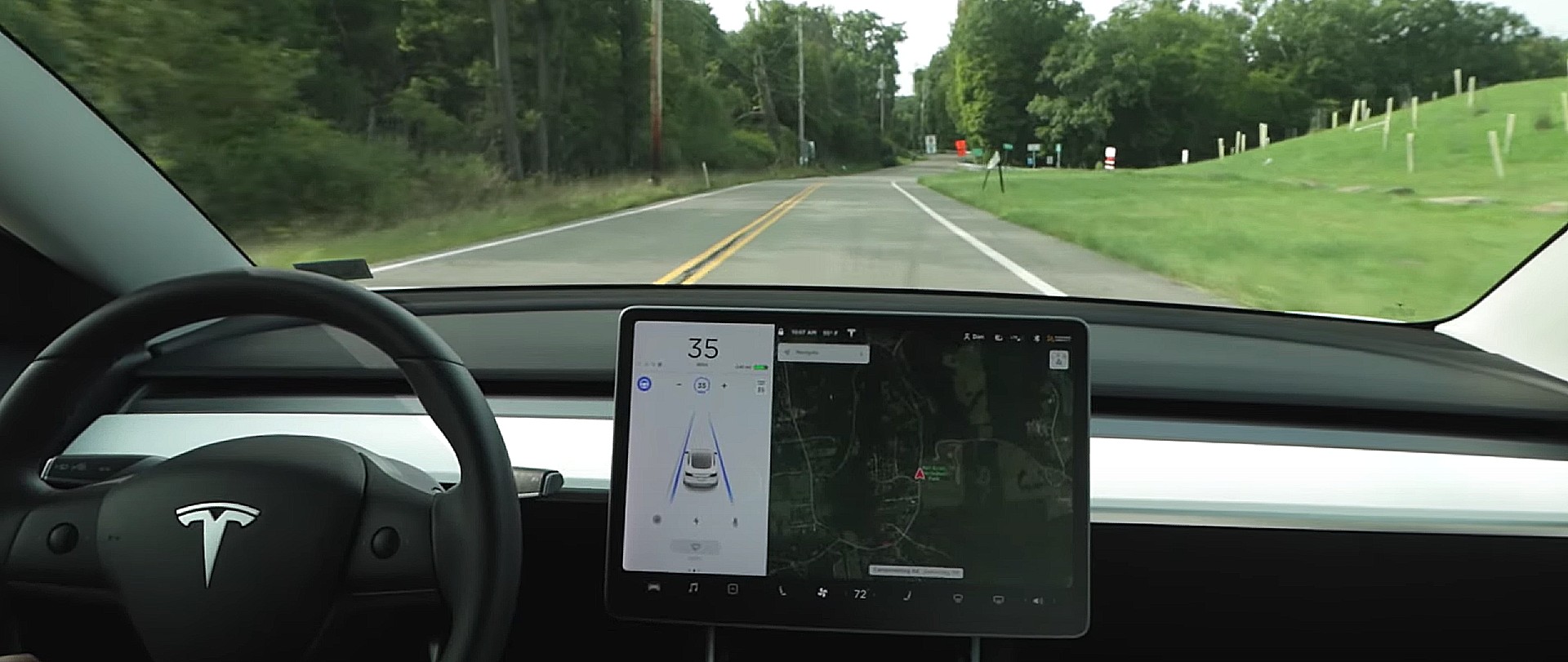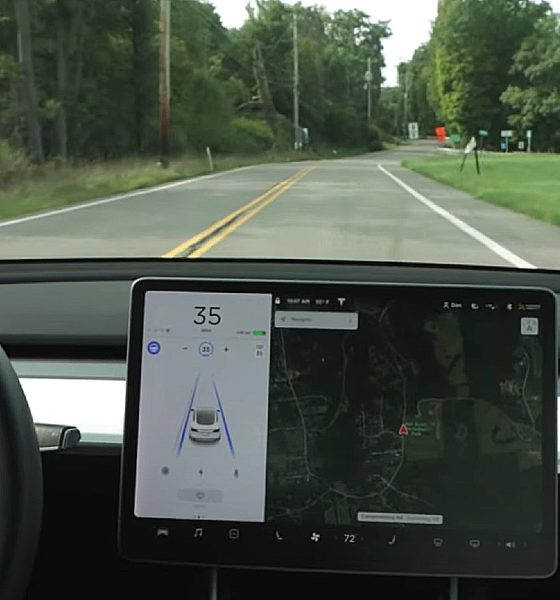

News
Tesla’s date-specific releases are spelling trouble for competing car companies
Tesla continues to release the newest and most exciting features in automotive technology on what seems like a daily basis. Recently, CEO Elon Musk has dropped several exciting developments dealing with manufacturing, battery technology, or Self-Driving functionality, all pointing toward the beginning of the end of the internal combustion engine industry. With every strategically-timed feature that Tesla releases, the ICE industry suffers another hit, making the numerous manufacturers that have been around for nearly a century rethink their strategies for the future as consumers look for new technology in cars. Tesla has established itself as the leader in moving the automotive industry forward.
Just last week, Musk stated on Twitter that Tesla would be releasing a “zero-intervention” version of the FSD suite, allowing owners to have their cars drive to destinations with no real responsibilities being left on the driver.
Musk confirmed the exact date of release earlier this morning, saying that the feature will be subject to a “limited FSD beta” on October 20th. The release date is “as promised,” as last week, the CEO indicated that it would be released “in a few weeks.”
Limited FSD beta releasing on Tuesday next week, as promised. This will, at first, be limited to a small number of people who are expert & careful drivers.
— Elon Musk (@elonmusk) October 12, 2020
Tesla has been fairly accurate with its timeframes in terms of releasing new technology to owners. However, there have been a few times in the past where the company has released something a few days, weeks, or months past the announced date. Usually, delays come down to whether the feature or functionality is ready for public use. When it comes to self-driving or semi-autonomous driving features, mistakes must be minimal. Tesla has to be sure that all bases are covered before releasing even a new characteristic’s limited-version.
Without performing the proper due-diligence, Tesla could be set back for months or even years. The company must continue to use its strive for perfection to its advantage. But now, Tesla is becoming more accurate with its timeframes, which spells significant amounts of trouble for other carmakers.
When the Full Self-Driving suite was aimed at a “feature complete” release toward the end of last year, many enthusiasts knew it would be tough for Tesla to complete this task. After the goal was not met, Musk indicated that Tesla would continue to work on the FSD suite and would release new features intermittently. Tesla did just this.
One of the most relevant examples of this is the Traffic Light and Stop Sign Control feature that became available in April 2020. When initially released, it required users to confirm that an intersection was safe for navigation by confirming it through the driving stalk. In June, Tesla removed the need for driver confirmation, allowing cars to navigate through intersections without driver intervention.
Tesla has kept its word with releasing features. However, what has been missing is an accurate timeframe, which has kept owners guessing about which features will be available at what times. But, Tesla is improving with this and is becoming more deliberate with keeping up with goals.
With more predictable release dates, Tesla becomes significantly more dangerous to legacy and ICE automotive companies. Knowing exactly when features will be ready and when the public will have the opportunity to experience them is effectively Tesla digging the six-foot deep hole where ICE car companies will lie within a few years. It means Tesla is developing functionalities in a timely fashion with accuracy and confidence.
Even though the feature is not a wide-release, FSD features rarely are. They often start with Tesla employees, and then roll out to members of the company’s “Early Access Program.” After the bugs and kinks, if there are any, are modified, then the wide-release begins.
As Tesla continues to raise the bar in semi-autonomous driving, electric vehicle technology, and EV battery functionality, it is evident that soon, there will be no more advantages to driving a car that is powered by gas. While fun for some, driving is a chore for others, and FSD will give those who are forced to travel the opportunity to have cars drive themselves.
The big picture of Tesla is narrowing down specific release dates for features is that their approach is becoming more calculated, defined, and precise. All of which are a disaster for traditional car companies who are still lagging in EV development and Advanced Driver Assistance features. Tesla is pulling away, not only literally, but metaphorically, as well.

News
Tesla FSD fleet is nearing 7 billion total miles, including 2.5 billion city miles
As can be seen on Tesla’s official FSD webpage, vehicles equipped with the system have now navigated over 6.99 billion miles.

Tesla’s Full Self-Driving (Supervised) fleet is closing in on almost 7 billion total miles driven, as per data posted by the company on its official FSD webpage.
These figures hint at the massive scale of data fueling Tesla’s rapid FSD improvements, which have been quite notable as of late.
FSD mileage milestones
As can be seen on Tesla’s official FSD webpage, vehicles equipped with the system have now navigated over 6.99 billion miles. Tesla owner and avid FSD tester Whole Mars Catalog also shared a screenshot indicating that from the nearly 7 billion miles traveled by the FSD fleet, more than 2.5 billion miles were driven inside cities.
City miles are particularly valuable for complex urban scenarios like unprotected turns, pedestrian interactions, and traffic lights. This is also the difference-maker for FSD, as only complex solutions, such as Waymo’s self-driving taxis, operate similarly on inner-city streets. And even then, incidents such as the San Francisco blackouts have proven challenging for sensor-rich vehicles like Waymos.
Tesla’s data edge
Tesla has a number of advantages in the autonomous vehicle sector, one of which is the size of its fleet and the number of vehicles training FSD on real-world roads. Tesla’s nearly 7 billion FSD miles then allow the company to roll out updates that make its vehicles behave like they are being driven by experienced drivers, even if they are operating on their own.
So notable are Tesla’s improvements to FSD that NVIDIA Director of Robotics Jim Fan, after experiencing FSD v14, noted that the system is the first AI that passes what he described as a “Physical Turing Test.”
“Despite knowing exactly how robot learning works, I still find it magical watching the steering wheel turn by itself. First it feels surreal, next it becomes routine. Then, like the smartphone, taking it away actively hurts. This is how humanity gets rewired and glued to god-like technologies,” Fan wrote in a post on X.
News
Tesla starts showing how FSD will change lives in Europe
Local officials tested the system on narrow country roads and were impressed by FSD’s smooth, human-like driving, with some calling the service a game-changer for everyday life in areas that are far from urban centers.

Tesla has launched Europe’s first public shuttle service using Full Self-Driving (Supervised) in the rural Eifelkreis Bitburg-Prüm region of Germany, demonstrating how the technology can restore independence and mobility for people who struggle with limited transport options.
Local officials tested the system on narrow country roads and were impressed by FSD’s smooth, human-like driving, with some calling the service a game-changer for everyday life in areas that are far from urban centers.
Officials see real impact on rural residents
Arzfeld Mayor Johannes Kuhl and District Administrator Andreas Kruppert personally tested the Tesla shuttle service. This allowed them to see just how well FSD navigated winding lanes and rural roads confidently. Kruppert said, “Autonomous driving sounds like science fiction to many, but we simply see here that it works totally well in rural regions too.” Kuhl, for his part, also noted that FSD “feels like a very experienced driver.”
The pilot complements the area’s “Citizen Bus” program, which provides on-demand rides for elderly residents who can no longer drive themselves. Tesla Europe shared a video of a demonstration of the service, highlighting how FSD gives people their freedom back, even in places where public transport is not as prevalent.
What the Ministry for Economic Affairs and Transport says
Rhineland-Palatinate’s Minister Daniela Schmitt supported the project, praising the collaboration that made this “first of its kind in Europe” possible. As per the ministry, the rural rollout for the service shows FSD’s potential beyond major cities, and it delivers tangible benefits like grocery runs, doctor visits, and social connections for isolated residents.
“Reliable and flexible mobility is especially vital in rural areas. With the launch of a shuttle service using self-driving vehicles (FSD supervised) by Tesla in the Eifelkreis Bitburg-Prüm, an innovative pilot project is now getting underway that complements local community bus services. It is the first project of its kind in Europe.
“The result is a real gain for rural mobility: greater accessibility, more flexibility and tangible benefits for everyday life. A strong signal for innovation, cooperation and future-oriented mobility beyond urban centers,” the ministry wrote in a LinkedIn post.
News
Tesla China quietly posts Robotaxi-related job listing
Tesla China is currently seeking a Low Voltage Electrical Engineer to work on circuit board design for the company’s autonomous vehicles.

Tesla has posted a new job listing in Shanghai explicitly tied to its Robotaxi program, fueling speculation that the company is preparing to launch its dedicated autonomous ride-hailing service in China.
As noted in the listing, Tesla China is currently seeking a Low Voltage Electrical Engineer to work on circuit board design for the company’s autonomous vehicles.
Robotaxi-specific role
The listing, which was shared on social media platform X by industry watcher @tslaming, suggested that Tesla China is looking to fill the role urgently. The job listing itself specifically mentions that the person hired for the role will be working on the Low Voltage Hardware team, which would design the circuit boards that would serve as the nervous system of the Robotaxi.
Key tasks for the role, as indicated in the job listing, include collaboration with PCB layout, firmware, mechanical, program management, and validation teams, among other responsibilities. The role is based in Shanghai.
China Robotaxi launch
China represents a massive potential market for robotaxis, with its dense urban centers and supportive policies in select cities. Tesla has limited permission to roll out FSD in the country, though despite this, its vehicles have been hailed as among the best in the market when it comes to autonomous features. So far, at least, it appears that China supports Tesla’s FSD and Robotaxi rollout.
This was hinted at in November, when Tesla brought the Cybercab to the 8th China International Import Expo (CIIE) in Shanghai, marking the first time that the autonomous two-seater was brought to the Asia-Pacific region. The vehicle, despite not having a release date in China, received a significant amount of interest among the event’s attendees.








